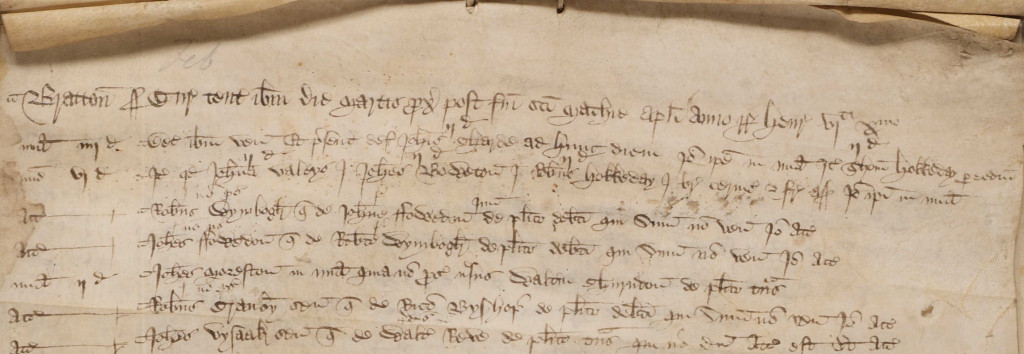Bratton Clovelly Manor Rolls
The concept of ‘manors’ arrived in England and Wales with William and the Domesday Book. His surveyors assumed that all land was owned by the Crown and distributed to lords, or Tenants-in-Chief, who owed military service in return. As the land was let to tenants, the concept evolved into specific areas of land that were worked by tenants for the lord of the manor. Although the concept of manor evolved greatly through the centuries, traditions persisted and the last Lady of Bratton Manor appears to have been Elizabeth Manning who was buried at St Mary’s in 1913.
We are fortunate to have a stunning survival of many Bratton Clovelly rolls loaned to the Devon Record Office in the 1950s and now preserved for the future. Some years back, Devon Heritage Centre digitised these rolls for us and we arranged to have them translated by Brooke Westcott, a professional Latin translator. We are delighted to say that the translations can now be viewed by clicking on the links below. The following rolls are accessible, with information on over 60 court sessions :
- 1377-78: 4 sessions
- 1395-98: 3 name lists (included with the 1408-09 court roll)
- 1408-09: 7 sessions
- 1416: 3 sessions
- 1422-23: 9 sessions
- 1431-32: 8 sessions
- 1438: 4 sessions
- 1493: Compotus (account)
- 1552-53: 5 sessions
- 1627-28: 10 estreats (lists of fines)
- 1684-85: 10 sessions
For an overview of the types of information that we discovered in the rolls, a presentation to the Guild of One-Name studies is available on YouTube. Also, Rev T Whale studied the Bratton Clovelly manor rolls and surviving deeds in the late 1800s and prepared an excellent article entitled “Manors in Bratton Clovelly” for the Transactions of the Devonshire Association.
For those of you new to research in this timeframe, some of the terms and processes may be unfamiliar. You may find that some of the following helpful to your understanding of the rolls:
- For a general glossary of terms you might find in manor rolls, see Glossary for Manorial Records.
- If you want to explore the manor records for your own place of interest, an approach is suggested in Manorial Records in 16th to 18th Century Research.
- For a discussion of court proceedings in manorial courts, see Mulholland’s Trials in manorial courts in late medieval England.
- For more understanding of how villagers used their manorial courts, some interesting research by Briggs & Schofield is available in Understanding Edwardian villagers use of law.
Note that The National Archives has engaged in further work on the Manorial Documents Register and identified another four manor documents for Bratton Clovelly Manor. The Register also lists four documents for Boasley Manor which was also within the boundaries of the present-day parish of Bratton Clovelly. We plan to make translations of these additional documents available on the website as soon as possible.
